Rebuilding NiCd Rechargable Power Tool Battery Packs
The second most important tool in your telescope building toolbox is your cordless drill (the most important is your router). The problem with cordless drills is that the batteries only last a few years, and they cost more to replace than the entire drill kit you bought in the first place. The specs on my packs state that you should get 250 charging cycles out of them.
I dare say that most people can rebuild their pack totally free.
Besides saving money, why would I want to rebuild a battery pack?
Reason number one is that usually only one or two cells in the whole pack are bad. So when you throw them out (please recycle your batteries!) you are throwing out twelve or more batteries that are still good!
Reason number two is that you can put higher capacity batteries in the packs and create packs with up to four times the runtime of the originals.
How do I Know When My Pack Needs Rebuilding?
When you only get a few minutes of runtime out of your pack, you get that sinking feeling that you are out another bucks. But you can do some checking long before it gets this bad with a Volt Meter.
When you first take a pack off the charger it should read higher than the voltage printed on the pack. NiCd Dewalt drill batteries loose about 25% of their charge in a month of sitting on a shelf. This is called “self discharge”. So, you really need to check your pack with a fresh charge.
A good condition battery that is 18V might read 21V fresh from the charger. A 14.4V might give you 16V. As long as it is higher than the rating, you are in good shape.
Your battery that only gives a few minutes of runtime might read only 10V when it is rated for 14.4V, this is a problem.
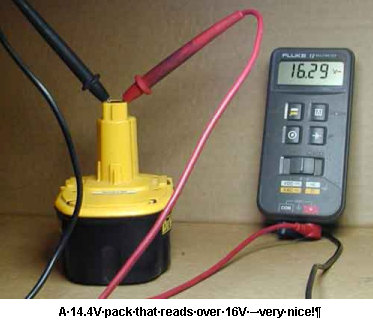
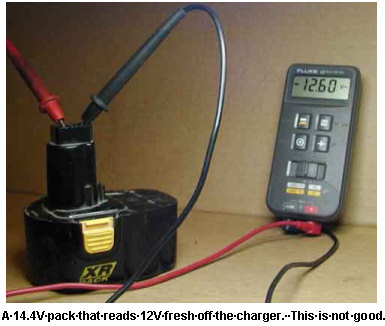
How do I Open The Pack for Service?
There are some screws along the pack that allow it to be opened. Sometimes they are Star or Security head screw. If you can’t find a way to get a grip on them, get a Security bit set at Harbor Freight. Rub your fingers over the label to see if some of the screws are hidden underneath it.
On some cheaper import packs, they are glued together and have to be carefully cut apart. Don’t even think of trying this without a vise to securely hold the pack. Run a brand new razor blade along the seam until you can rock the pack apart. This will take some time. But it will give you time to think about buying American tools too.
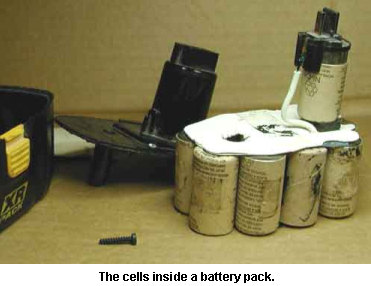
What is Inside?
Inside you will find a number of “Sub C” battery cells. Each cell reads about 1.2V. So an 18V pack will have 15 cells in it. The cells are taped or shrink-wrapped together, to keep vibration from loosening the contacts. You will need to cut off this tape. You will rewrap it when you are done with the repair.
How do I Know What Cells are Bad?
Again, we are going to use the Volt Meter. Place one lead at the bottom and top of each cell. Cells that read 1.3V (remember this is with a fresh charge) are good. You do not have to separate any of the cells to test them. Cells that read 1.1V are going and any cell under 1V is bad. Some cells may be totally dead and not read anything. With a Sharpie, mark good cells with a “G” and put an “X” on bad cells.
You may think why bother replacing cells that are almost good, like the 1.1V ones. If you taking the time to do a quality repair, why would you want to repeat the same process in a few months when the cell finally goes? Do the job once, and do it right.
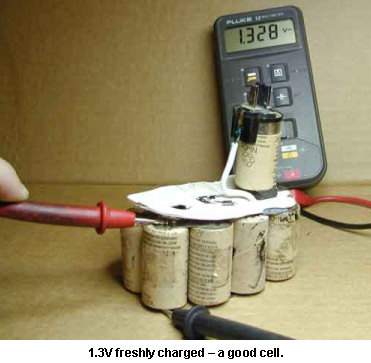
How do Get The Bad Cells Out?
As you have probably noticed, the cells are spot welded together. I have never seen a pack where actual solder was used. Take a small, sharp wood chisel and push between the tab and the top of the battery. You may have to lift a little. Take your time on the first one; the rest will go like butter once you have the feel for it. Leave the tabs behind on the good batteries.
Put a piece of tape on the chisel to remind yourself to sharpen it before it goes back to the woodworking it was made for.
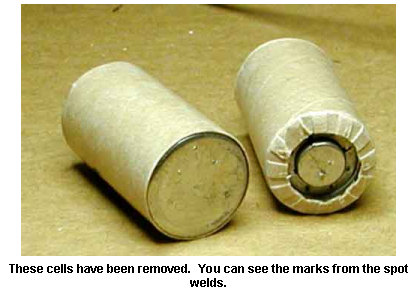
Iinstalling The New Cells
Using electrical tape, wrap the cells tightly so they will stay in place while you solder. This will be the cells “final resting place”, so get the formation right, they have to fit back in the plastic housing. Remember these cells get warm in use, so use real UL listed tape, not masking tape or crap you got at the dollar store. Make sure you get the polarity right. All of the cells go together head to tail, positive to negative.
Use solder with a low wattage iron. Heat the tab AND the battery top so you get a good joint.
When you are done, check the contacts at the top of the pack to make sure you get the correct voltage. If you get some odd reading, you have soldered one of the batteries in backwards! Fix this right away. If your spouse or kids put the pack in the charger, it could explode or cause a fire.
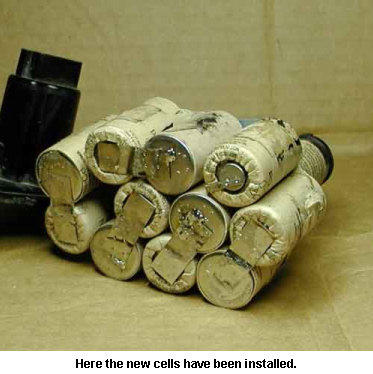
The Big Wrap Up
Now all you have to do is reassemble the pack. Make sure all the cells are wrapped together tight with electrical tape. They should not move or shift around. Screw everything back in place and test the contacts one more time for proper voltage.
If you had a pack that had to be cut apart to open it, use PVC cement to glue it back together.
Place the pack in the charger and charge it up. It may well be a good idea to keep an eye on it the first time; you can never be too safe.
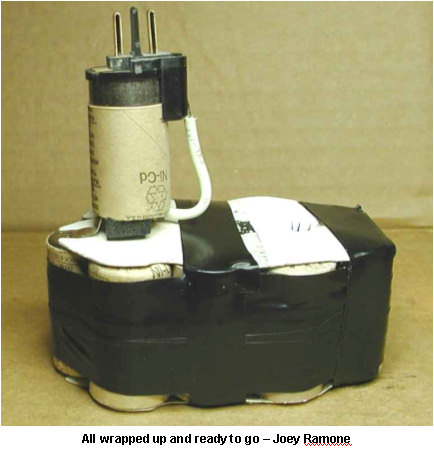
Where do I Get Replacement Cell From?
Remember earlier when I told you that most dead packs only have a few bad cells? All of your friends have dead packs sitting around their houses. Just ask them to give their dead packs to you. It does not matter if they have 9.6V, 18V Makita battery or 24V; you are just going to take them apart for the 1.2V cells. Most people will never get around to taking those packs to the recycler, so you are doing them (and the Earth) a favor.
These packs have often been sitting for quite a while, so have your friend charge them up before you open them. Your own charger may or may not fit your friends pack. This way you can see which cells hold a charge.
How to Get The Mostout of Your Packs
- Keep batteries out of extreme heat or cold. High temperatures age the chemicals inside batteries prematurely.
- Never run a battery all the way down. The moment you notice a change or slowdown, it is time to swap packs. Modern NiCd batteries do NOT have “memory effect”. Never put a rubber band around the trigger to completely drain a battery on the advice of a crazy old-timer.
- Top off batteries before storage. When done with the day’s work, recharge your packs before putting them away. Many modern chargers have a “deep-charge” mode that conditions batteries when left in the charger overnight. Consult your manual to see if your charger has this feature.
- Charge up side down. Your charger creates a lot of heat when it is charging, especially if the pack is really low. Flip the charger so the battery is on the bottom and the charger is on top. This lets the heat from the charger rise and dissipate without further heating the battery.
Save some coin and save the Earth at the same time.